Abstract
Today, a high level of shopping service is in great demand. Studying the aspects of consumer psychotypes with regard to the perception of the service, it can be noted that the most appropriate typology for studying consumer psychology is the typology of information perception. Analyzing the research data, based on the typology of consumers by the type of information perception obtained as a result of the survey, we can say that by defining the client's psychotype, as well as highlighting the service criteria that are important for them (interior, design, comfort, music, smells, tact of the staff), you can create an ideal service for the consumer and place it on a psychological level. This study shows the relationship between the psychological characteristics of the service and the typology of consumers based on the perception of information. Conducting such research can show which criteria are most important to customers when organizing psychological aspects of the service. An algorithm for improving service activities is described, taking into account the use of consumer psychotypes. It can be argued that the practical application of the typology of information perception by consumers with one of the methods of analysis of service activities can give a positive result when eliminating errors associated with the organization of service in the enterprise.
Keywords: Servicetradeconsumer psychotypemarketing
Introduction
Nowadays a high level of commercial service is in high demand. Most buyers prefer organizations, which can provide them advanced service capabilities (Faizova, 2005).
High-quality service increases the competitiveness of the trading company and increases the number of regular customers. Customer loyalty is important, as increasing sales to regular customers requires less cost than attracting new ones, this is the relevance of the service.
Many companies have realized that service is one of the most important criteria in order to be competitive. “Aeroflot” PJSC pays great attention to the safety and comfort of its customers. In the development program the company indicates, that for them service is an essential factor in successful business. In the service development strategy, the company plans to provide comfortable conditions for sitting and sleeping passengers. The company is going to introduce a new class of service “comfort” with seats of increased comfort, it will be laid out, and the client will take a position, reclining, which in turn is very convenient for many passengers. Interestingly, customer focus is one of the most important components of total quality management (TQM). Although TQM has been popular in manufacturing since 1980, its suitability in the public sector was discussed and studied by Chen (2005) as a model of a customer-oriented system for improving the quality of service in the public sector.
The service concept does not change the main marketing goals, but only shifts the emphasis in the overall marketing solution. This shift is in the direction of the service offered to consumers, or building an effective system of their service, which allows you to attract more and more customers, as well as expand the system of regular customers who get satisfaction from the service provided by the company.
Problem Statement
Many companies declare the service as part of their strategy, digitize its parameters and levels, and train their staff in sales techniques and service standards. But this misses the understanding of the deep motives of the consumer, his psychological comfort, unconscious perception of the quality of service, which is also important in terms of minimizing the points of contact of the consumer with the contact staff, remote service.
Analyzing textbooks, methods of analysis and evaluation of service activities at the enterprise, as well as training programs for the staff of trading companies, we can confidently say that many sources of educational literature, training and methods affect some aspects of consumer psychology. At the moment, there are no methods that are based on studying the perception of the service based on the psychological characteristics of consumers.
In modern market conditions, much attention is paid to the study of the personality of the consumer, namely the psychology of the consumer. Methods of influencing the consumer are being developed to stimulate and make a purchase. Psychological methods and factors are studied in the organization of the service process.
Applying of the principles of behavioral psychology can improve the quality of interaction with customers and increase brand awareness as a customer-oriented organization.
Research Questions
A large number of studies in behavioral psychology offer valuable information on how clients experience interaction with the service and form their opinions and memories of these meetings. Studies conducted by Nobel laureates Daniel Kahneman and George Levenshtein constitute the basis on which the practical principles of consumer exposure and impact assessment have been developed. In addition, the work of authors such as Ariely et al. (2018); Gneezy et al. (2019), Flory et.al. (2018), Thaler (2017) have also had a significant impact on how people take decisions. Although people take decisions, their preferences regarding the considered attributes change, that means they behave elastically: in the absence of situational pressure, they rely on basic levels, but in the decision-making process they transform into support for the chosen options, which elasticity contributes to confident decision-making when there are several, including in the service industry (Simon & Spiller, 2016; Yang et al., 2018). Bullard and Manchanda (2017) provided new empirical evidence of customer behavior at various stages to achieve the organization's goal. Their research shows that consumers in the early (late) stages of achieving a goal, as a rule, adopt a promotion-oriented (sustainability) way of thinking, using the initial state (desired final state) to measure progress in achieving the service goal.
In some works (Dedov & Smirnova, 2016), attention is drawn to the need to develop effective socio-psychological methods of psychological and psychophysiological adaptation of the working population to digital activities.
Consumers can make purchases using a memory search, recalling their planned purchases from memory, and directly looking for products. The results of the study (Fernandes et al., 2016) confirmed that when using incentive-based shopping, consumers sometimes even better remember products that they buy rarely (often).
Psychological phenomena that occur during the interaction of people are investigated by social psychology, one of the applied branches of which is the psychology of service, or the psychology of service. In this area, general patterns have a peculiar coloring. For example, the communication of service personnel with customers is characterized by features that are absent in the communication of the work team or family. Therefore, in order to understand the behavior of a person acting as a client, a service worker needs to know the psychology of the service process — in particular, the motives, reasons, and goals that guide clients (Smirnova, 2015).
Human psychology is individual, but psychologists were able to identify certain similarity traits of characters and unite individuals into groups and develop many typologies. We can say that psychology plays a large role in the organization of the service, because it includes many psychological characteristics important for the client.
Purpose of the Study
Analyzing the psychological characteristics in the methods of analysis of service activities and consumer behavior, the problem was revealed that there are no existing methods and studies that would be based on the study of service perception based on consumer psychology. But there are typologies of psychotypes, which, in our opinion, can help in the study of the psychological characteristics of the service.
Research Methods
In psychological practice, there is a typology by which it is customary to distinguish consumers, namely by the type (channels) of perception of information. To study the psychological criteria of the service, this typology was chosen: visual, audio, kinesthetic and digital. The research was conducted using questionnaires in Kemerovo. The main stream of respondents were students and employees of the University of KemSU. The focus of the questionnaire is to identify what consumers understand by “service” and to determine the possible compliance of consumer psychotypes with the main criteria for effective service activities when purchasing goods or services.
Findings
The questionnaire contains closed and semi-closed questions, consists of 6 questions. The questionnaire is presented in Application A.
107 people participated in the survey.
The number of male respondents was 22 persons (21%), and 85 women (79%). The diagram of the ratio of the number of respondents is presented in Figure
The number of male respondents was 22 persons (21%), and 85 women (79%). The diagram of the ratio of the number of respondents is presented in Figure
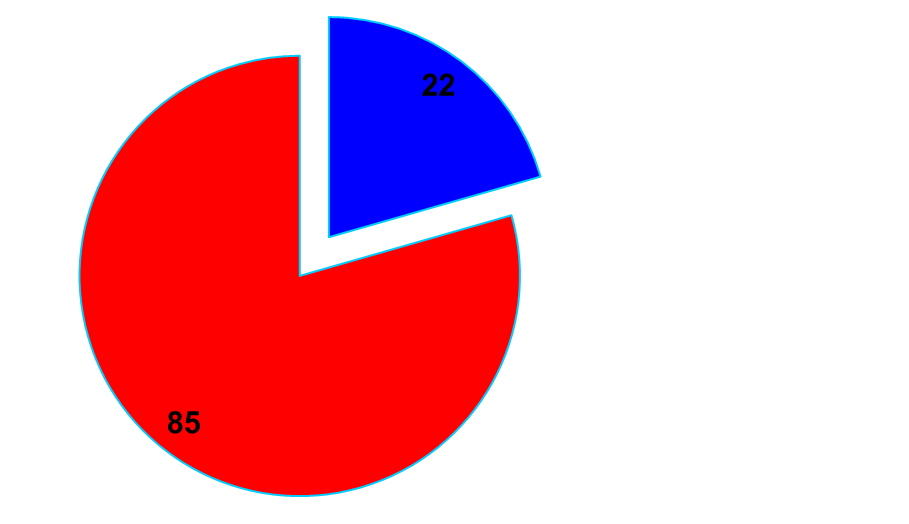
The number of respondents who participated in the survey:
up to 20 years – 17 people (16%);
from 21 to 25 years – 70 people (65%);
from 26 to 35 years – 16 people (15%);
from 36 to 45 years – 2 people (2%);
from 46 to 55 years – 2 people (2%);
from 56 and older – did not attend (0%).
Figure
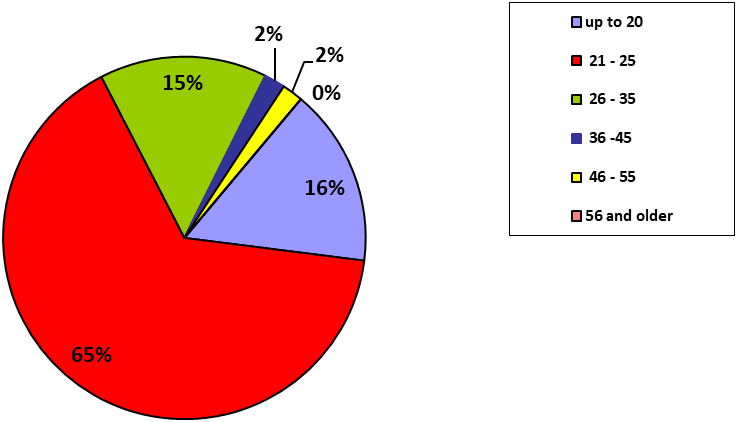
To the question, "What kind of psycho-type do you belong to?" 60 people out of 107 respondents answered that they are visual. The number of audio - 6 people, 26 respondents answered that they are kinesthetic, and only 15 people consider themselves to digital (Figure
A lot of socio-psychological studies conducted on the Russian territory suggest that the number of people who consider themselves to “visual” psychotype is the largest number of people – 40%. Also next to this psychotype is “kinesthetic”, the number of people who consider themselves to this psychotype is 30%. The least common psycho-types are digital, which make up 20% of the population, and audio – only 10%.
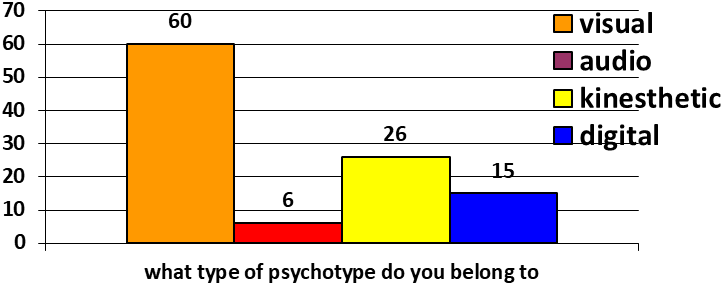
The study on the determination of consumer psychotypes confirmed the data of socio-psychological studies on the main types of consumers based on the typology of perception of information.
On the question “What do you mean by the word “Service”?” The following results were obtained.
93 people chose the second option “Customer service and facilities” (80 %);
12 respondents answered that service means “individual approach to customers” (10 %);
10 people answered that service means “Service Availability Anytime” (9 %);
1 respondent said that service means “Repair a technically complex product” (1%);
None of the respondents suggested their answer (0 %).
The modern consumer became more discriminating in the concept of service. We can say that for the majority of respondent’s service is creation of amenities for the client. It is important to note that the majority of respondents are visuals and kinesthetic, for whom the service is precisely the psychological component of comfort and creating amenities for the client.
Figure
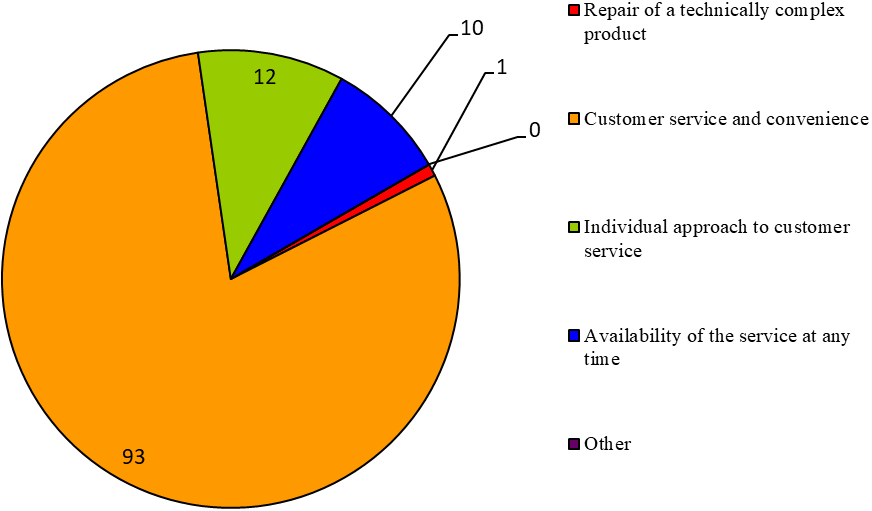
From table
comfort (30);
cleanliness (29);
Interior (29).
For respondents who attribute themselves to the “audio” psychotype, consider that important criteria of the service are:
competent staff speech (3) ;
informed staff about the product / service / goods (3);
information availability (3);
For “kinesthetic” psycho type the most important criteria are:
cleanliness (20);
informed staff about the product / service / goods (12);
the availability to touch or hold in hands the product what is going to buy (10).
Respondents who consider themselves to the “digital” psycho type noted that the following service criteria are:
informed staff about the product / service / goods (6);
it is important that staff explain the structure of actions that will occur at the time of receiving the service (10);
information availability (6);
logicality (certain actions that you understand) (6).
For all psycho types important criteria:
competent staff speech;
informed staff about the product / service / goods;
tact of the staff.
It should be noted that for consumers it is always important how the information is presented. The presence of complete and truthful information about a product, service or product always has a customer. That's why unusing at the highest level these criteria is considered ignorance, bad form while working with a client.
The emotional component of the service in modern society is very important, the client should feel comfortable and confident by receiving the service or being in a restaurant or in a shopping center, etc.
Analyzing the research data, based on the typology of consumers by the type of perception of information obtained as a result of the questionnaire, we can say that determining the client’s psychotype, as well as highlighting important service criteria (interior, design, comfort, music, smells, tact of staff), You can create the perfect service for the consumer and arrange it on a psychological level.
Carrying out such studies can show which criteria are most important based on the psychotype of the client when organizing the psychological aspects of the service. Also, such a typology of dividing consumers by type of perception of information can serve as the basis for the development of a new methodology for evaluating service from the psychological criteria that are most significant for the client.
Existing methods for analyzing the effectiveness of customer service affect consumer psychology, but there are no existing methods and practices that would be based on the study of consumer psychotypes as the basis for building a service.
In turn, the SERVQUAL and INDSERV methods significantly affect the psychological criteria of the service, which are important for the consumer, but it is very difficult for the researcher to understand the essence of the negative assessment of clients of the level of service.
In order for the service criteria to be successful, it is necessary to clearly imagine the target audience of the company's consumers, consumer segmentation is used, based on socio-demographic parameters, such as gender, age, education, income, etc., but also study consumer psycho types.
By studying the psycho types of the target audience, you can get a greater flow of information that the company can use to realize its goals in service activities. It can be argued that by studying the client’s psycho type, one can create a high-quality service for the consumer and arrange it at a psychological level and thereby be competitive in the market.
So, the typology of perception of information can serve as the basis for improving the methods of analysis of service activities.
In turn, the author proposed an improved technique, which involves action according to the algorithm shown in Figure
Let's describe the essence of the action of the improved service activity algorithm.
1. Setting goals and objectives.
For making research companies should clearly set goals and objectives, further result depends on it. So, companies of all industries and fields of activity can set the following goals:
service improvement;
increasing customer loyalty;
increasing competitiveness;
increase in economic efficiency of the enterprise.
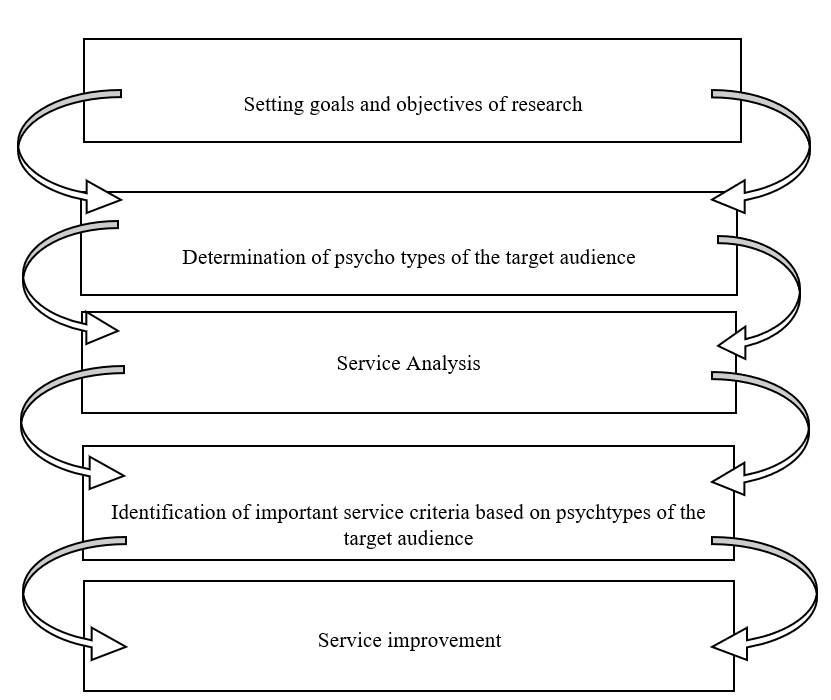
2. Determination of psycho types of the target audience.
For determination of psycho types of the target audience, the author developed a questionnaire for the research of psycho types of the target audience. An example of a questionnaire for identifying psychotypes of a target audience is presented in Application B. A questionnaire for researching psychotypes of a target audience consists of 31 closed-ended questions (statements).
Respondents are asked to agree or disagree with these statements. Each questionnaire is analyzed separately using a key-answer for the questionnaire, which is presented in Application B.
The key:
visual – 1, 4, 5, 6, 12, 19, 27;
kinesthetic – 3, 8, 11, 16, 17, 18, 26, 31;
audio – 2, 7, 9, 10, 13, 15, 20, 21, 24;
digital – 14, 22, 23, 25, 28, 29, 30.
After the interviewers conducted an analysis of psycho types and identified in their target audience the number of visuals, kinesthetic, audio and digital, the company proceeds to analyze the service.
3. Analysis of service activities.
To identify problems associated with the service in the company, it is necessary to analyze the service activity using one of the methods for evaluating the service. The most suitable methods for analyzing service activities are the “SERVQUAL” and “INDSERV” methods.
It is important to note that when describing various criteria for the quality of service in one of the above methods, the company should rely on the psycho type of the target audience. This can help to identify the very essence of the problem when organizing service at the enterprise.
During the analysis of service activities using one or another method, one may encounter the problem of incomplete expression of information from the analysis. So, for example, when conducting an analysis of service activities according to the “SERVQUAL” method, answering the question of the questionnaire “The design of the office of a travel agency is attractive”, the respondent gives a rating of 6 out of 7 in the column “Waiting”, 4 out of 7 in the column “Perception”, and Importance column 7 of 7.
It is very difficult to understand the reason why the respondent gave such a low rating in the column “Perception”, such a criterion as “Design” includes many sub-criteria from the color design of the sign to the chairs that are in the room and this criterion will be individual for each psychotype.
After the analysis, it is necessary to systematize the information received. Defining criteria that have a big difference between “expectation” and “perception” of consumers. It is necessary to proceed to the fourth step of the algorithm.
4. Identification of important service criteria based on psychotypes of the target audience.
All the criteria that scored a small number of points need to more fully describe the sub-criteria of statements for further analysis.
Based on the psycho types of the target audience by the type of perception of information, it is necessary to conduct a study that will show what is important for customers when organizing a service based on the results of the analysis of the service according to the methods proposed above.
So, for example, for such a cure as “Our experts competently and beautifully speak” in the column “Expectation” the average score is 6 out of 7, and in the column “Importance” 3 out of 7. It is difficult to find out the reason for the low score. Such a criterion as literate speech is important absolutely for all psycho types, this criterion can be described in more detail.
For example:
the specialist stutters;
the specialist “stumbles”
the specialist is talking quietly;
there is an accent in the specialist’s speech;
the specialist uses terminology that the consumer does not know.
After interviewing and systematizing the information received, it became clear that customers did not like the employee with a speech accent.
5. Service improvement.
After all researches identifying the problem, which was complex, its improvement takes place. The company uses various creative methods to eliminate it and thereby forms its ideal service for its target audience.
The result of the analysis was the identification of a problem that a specialist with an emphasis does not suit clients, this problem must be solved and the assessment of this criterion will immediately increase.
Conclusion
Applying a research on the typology of consumers based on the perception of information, with one of the methods of analysis of service activities can give a positive result. Since it describes the essence of the problem in much more detail, using consumer research on the type of perception of information and one method of evaluating the service, you can get more information.
Analyzing the information received, you can quickly find all the errors that the company makes in organizing the service at the enterprise, and solve them, thereby achieving the organization of the ideal service at the enterprise.
Acknowledgments
We would like to thank the anonymous reviewer for the constructive comments to improve the manuscript.
References
- Ariely, D., Gneezy, U., & Haruvy, E. (2018). Social Norms and the Price of Zero. Journal of Consumer Psychology, 180-191.
- Bullard, O., & Manchanda, R. V. (2017). How goal progress influences regulatory focus in goal pursuit. Journal of Consumer Psychology, 27, 302– 317.
- Chen, C-Q. (2005). An empirical analysis of customer-oriented service activities in the Taiwanese public sector. Total Quality Management and Business Excellence, 16(7), 887-901. https://doi.org/10.1080/14783360500077369
- Dedov, N. P., & Smirnova, M. E. (2018). Psychophysiological ensuring professional activity in the conditions of digital economy. Psychology. Historical-critical Reviews and Current Researches, 3A.
- Faizova, E. F. (2005). Service as a condition for successful business. Bulletin of Samara State University, 2, 79-84.
- Fernandes, D., Puntoni, S., van Osselaer, S. M. J., & Cowley, E. (2016). When and why we forget to buy. Journal of Consumer Psychology, 26, 363– 380. https://doi.org/10.1016/j.jcps.2015.06.012. Wiley Online LibraryWeb of Science®Google Scholar
- Flory, J., Gneezy, U., Leonard, K., & List, J. A. (2018). Gender, age and competition: A disappearing gap? Journal of Economic Behavior and Organization, 256-276.
- Gneezy, U., List, A. J., Livingston, J. A., Qin, X., Sadoff, S., & Xu, Y. (2019). Measuring Success in Education: The Role of Effort on the Test Itself, American Economic Review: Insights, 1(3), 291-308.
- Simon, D., & Spiller, S. A. (2016). The Elasticity of Preferences. Psychological Science, 27, 1588– 1599.
- Smirnova, M. E. (2015) The feasibility of using psycho physiological aspects in personnel management. Scientific almanac of the Central Chernozem region, 2, 122-124.
- Thaler, R. H. (2017). Behavioral Economics. Journal of Political Economy, 1799-1805.
- Yang, L., Toubia, O., & Jong, M. G. D. (2018). Attention, Information Processing and Choice in Incentive‐Aligned Choice Experiments. Journal of Marketing Research, 55, 783– 800.
Copyright information

This work is licensed under a Creative Commons Attribution-NonCommercial-NoDerivatives 4.0 International License.
About this article
Publication Date
21 October 2020
Article Doi
eBook ISBN
978-1-80296-089-1
Publisher
European Publisher
Volume
90
Print ISBN (optional)
-
Edition Number
1st Edition
Pages
1-1677
Subjects
Economics, social trends, sustainability, modern society, behavioural sciences, education
Cite this article as:
Shadrin, V. G., Kotova, O. N., & Konovalova, O. V. (2020). Using Consumer Psychology By Building Effective Communication. In I. V. Kovalev, A. A. Voroshilova, G. Herwig, U. Umbetov, A. S. Budagov, & Y. Y. Bocharova (Eds.), Economic and Social Trends for Sustainability of Modern Society (ICEST 2020), vol 90. European Proceedings of Social and Behavioural Sciences (pp. 1526-1536). European Publisher. https://doi.org/10.15405/epsbs.2020.10.03.176

